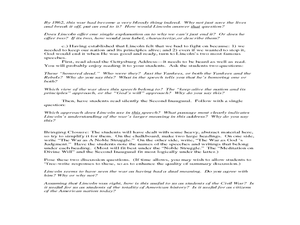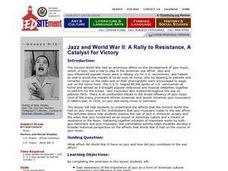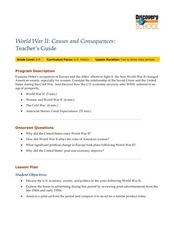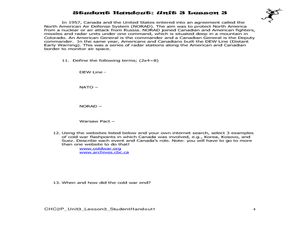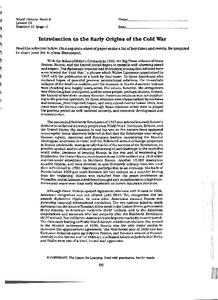Curated OER
The Cold War (1945–1963)
In this online interactive history worksheet, students respond to 8 short answer and essay questions about the Cold War. Students may check some of their answers on the interactive worksheet.
Curated OER
Cold War
Eleventh graders analyze U.S. foreign policy since World War II, tracing origins and geopolitical consequences (foreign and domestic) of the Cold War and containment policy.
Curated OER
The United States and the Soviet Union were Engaged in a Cold War
Students work together at figuring out the definition for what cold war means. In this social science instructional activity, students listen to "The Butter Battle Book" by Dr. Seuss and recognize how this story relates to the cold war...
Curated OER
Lincoln and the War’s Larger Meaning
Students analyze Abraham Lincoln's view of the Civil War. In this American Civil War activity, students read excerpts of Lincoln's speeches to determine whether he had a dual view of the war. Students respond to discussion questions...
Curated OER
The Legacy of the "Great War"
Students study how the map of Europe changed as a result of the Treaty of Versailles at the end of World War I. They examine the results of the end of the Cold War.
Curated OER
Jazz and World War II: A Rally to Resistance, A Catalyst for Victory
Students examine the impact of WWII on the development of jazz music and consider how jazz music helped to boost morale of both soldiers and those left at home. They identify the function of jazz as a cultural export and discuss its...
National Endowment for the Humanities
The House Un-American Activities Committee
Was the House Un-American Activities Committee justified in investigating subversive influences in the entertainment industry? Part two of the three-part series of lessons that examine the anti-communism movement after World War II,...
Curated OER
World War II: Causes And Consequences
Young scholars discuss the U.S. economy, society, and politics in the years following World War II. They explore the boom in advertising during this period by reviewing print advertisements from the late 1940s and early 1950s. ...
Curated OER
Brave New World
Students view a video about the effects of World War II on the map of Europe. They discuss the video and answer questions. They work together to identify accomplishments that best represent American culture.
John F. Kennedy Presidential Library & Museum
Military Advisers in Vietnam: 1963
How did the beginning of the Vietnam War factor into the Cold War with the Soviet Union? As part of a study of American involvement in Vietnam, class members read a letter address to President Kennedy and his response in which...
Foreign Policy Research Institute
Categories of Cold War Histiography
While the objective is to provide an overview of the Cold War in preparation for further study, this resource addresses the topic at a rather advanced level, and might need its own introductory lesson. The handouts include terms such as...
The New York Times
The Cold War: Crossword
This crossword puzzle focuses on clues related to The Cold War. It also has unrelated clues that would be a challenge to middle schoolers, but should be manageable to secondary students; particularly juniors taking US history. There are...
Curated OER
The Cold War: Solving the Mystery of History with Voices on Vinyl
Eighth graders explore the Cold War Era. In this world history lesson, 8th graders discover the positions taken by countries during the Cold War as they listen to lectures regarding the major events and turning points in the Cold War....
Curated OER
Introduction to the Early Origins of the Cold War
In this Cold War activity, students read a 4-paragraph selection about post World War II diplomacy and then list key dates and events noted in the selection.
Curated OER
Cold War Chronology
In this Cold War worksheet, students examine the chronological list of important events between 1945 and 1991. Students then respond to 7 short answer questions based on the chronology.
Smithsonian Institution
POWs
Why did Vietnam POWs and their families receive more media attention than POWs in previous wars? To answer this question, class members view artifacts, read articles, and engage in class discussion. Individuals then assume the...
Curated OER
The Cold War
In this Cold War worksheet, learners read 3 brief selections about the conflict and then respond to 13 short answer and multiple choice questions based on the selections.
Curated OER
The End of WWII and The Beginning of the Cold War
In this end of World War II and Cold War study guide worksheet, students fill in 44 blanks in a passage with the appropriate words to complete the sentences regarding the time period.
Curated OER
Who Was Responsible for the Start of the Cold War?
Young scholars determine who is responsible for the start of the Cold War. In this Cold War lesson plan, students conduct their own research about the evolution of the war and write essays that reveal their opinion on how the war began.
Curated OER
Introduction to the Early Origins of the Cold War
In this Cold War worksheet, students read an article titled "Introduction to the Early Origins of the Cold War," and then make a list of key dates and events from the selection.
Curated OER
Sources of the Cold War
Fourth graders make a time line from their notes and outlines of the causes of the Cold War.
Curated OER
Creating a Newscast on the Cold War
Learners research the events of a specific year of the Cold War. In this Cold War lesson, students investigate the causes of the Cold War and highlight the events of a particular year. Learners create a...
Curated OER
Multiple Perspectives on the Korean War
Students interpret historical evidence presented in primary and secondary resources. In this Korean War lesson, students examine and analyze primary sources regarding U.S. involvement in the Korean War.
Curated OER
The Causes of Prohibition
Eleventh graders explore the origins of the Prohibition Movement in the United States. In small groups, they analyze the influence of World War I in the passage of the eighteenth amendment. Students explain how different demographics of...



